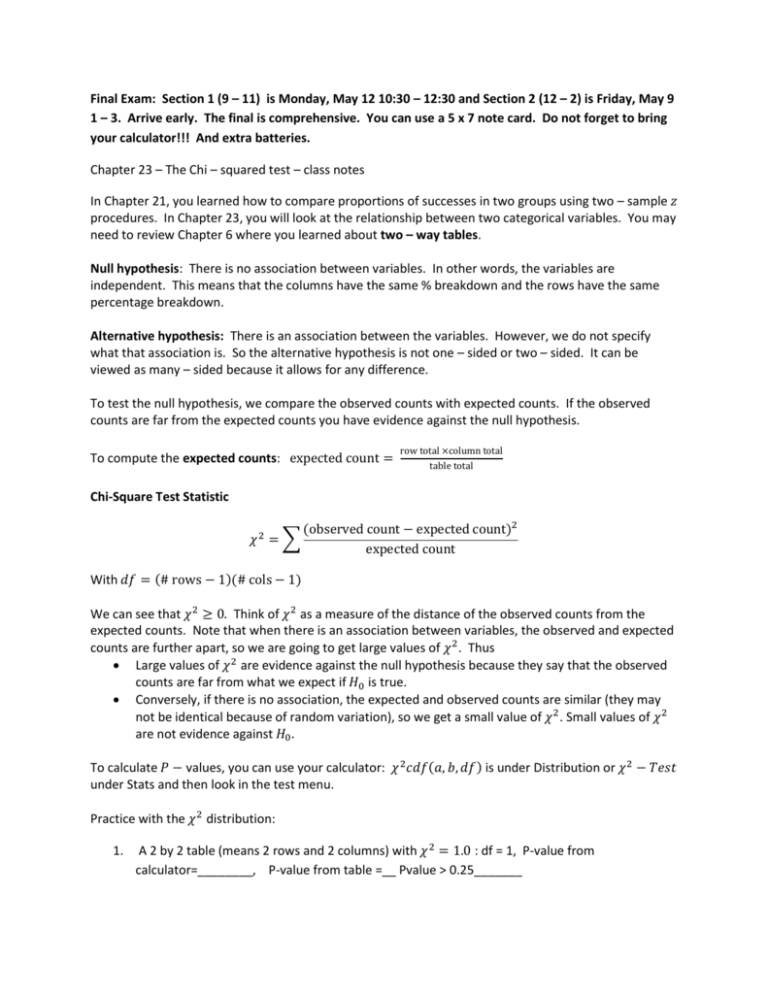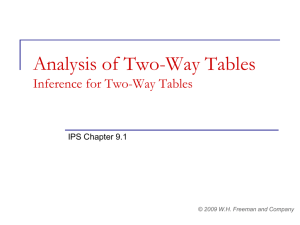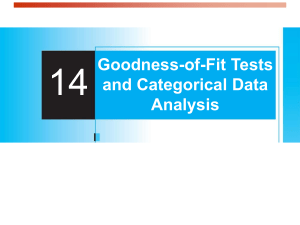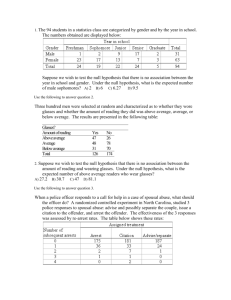Chapter 23 - Chi - Squared Test
advertisement

Final Exam: Section 1 (9 – 11) is Monday, May 12 10:30 – 12:30 and Section 2 (12 – 2) is Friday, May 9 1 – 3. Arrive early. The final is comprehensive. You can use a 5 x 7 note card. Do not forget to bring your calculator!!! And extra batteries. Chapter 23 – The Chi – squared test – class notes In Chapter 21, you learned how to compare proportions of successes in two groups using two – sample 𝑧 procedures. In Chapter 23, you will look at the relationship between two categorical variables. You may need to review Chapter 6 where you learned about two – way tables. Null hypothesis: There is no association between variables. In other words, the variables are independent. This means that the columns have the same % breakdown and the rows have the same percentage breakdown. Alternative hypothesis: There is an association between the variables. However, we do not specify what that association is. So the alternative hypothesis is not one – sided or two – sided. It can be viewed as many – sided because it allows for any difference. To test the null hypothesis, we compare the observed counts with expected counts. If the observed counts are far from the expected counts you have evidence against the null hypothesis. To compute the expected counts: expected count = row total ×column total table total Chi-Square Test Statistic 𝜒2 = ∑ (observed count − expected count)2 expected count With 𝑑𝑓 = (# rows − 1)(# cols − 1) We can see that 𝜒 2 ≥ 0. Think of 𝜒 2 as a measure of the distance of the observed counts from the expected counts. Note that when there is an association between variables, the observed and expected counts are further apart, so we are going to get large values of 𝜒 2 . Thus Large values of 𝜒 2 are evidence against the null hypothesis because they say that the observed counts are far from what we expect if 𝐻0 is true. Conversely, if there is no association, the expected and observed counts are similar (they may not be identical because of random variation), so we get a small value of 𝜒 2 . Small values of 𝜒 2 are not evidence against 𝐻0 . To calculate 𝑃 − values, you can use your calculator: 𝜒 2 𝑐𝑑𝑓(𝑎, 𝑏, 𝑑𝑓) is under Distribution or 𝜒 2 − 𝑇𝑒𝑠𝑡 under Stats and then look in the test menu. Practice with the 𝜒 2 distribution: 1. A 2 by 2 table (means 2 rows and 2 columns) with 𝜒 2 = 1.0 : df = 1, P-value from calculator=________, P-value from table =__ Pvalue > 0.25_______ 2. A 2 by 2 table (means 2 rows and 2 columns) with 𝜒 2 = 12.0 : df = 1, Pvalue from calculator=________, p value from table: 0 .0005 < pvalue < 0.001 3. A 3x3 table with 𝜒 2 = 5.45 df =___________ Pvalue from calculator =_________ 4. A 3x8 table with 𝜒 2 = 30.55 df =___________ P-value from calculator =_________ Example: Vitamin A is often given to young children in developing countries to prevent night blindness. It is observed that children receiving Vitamin A appear to have reduced death rates. One year after the start of the study in this area, the number of children who died was determined. This information is given in the following two by two table. I have added in the totals for each to make the calculations faster. Complete the 4 step of the hypothesis test. Survive? Vitamin A Control Group (no Vitamin A) Did not survive 101 130 Survived 12890 12079 total 12991 12209 total 231 24969 25200 Step 1: 𝐻0 : There is no association between survival and Vitamin A treatment 𝐻𝑎 : There is an association between survival and Vitamin A treatment Step 2: Calculate 𝜒 2 Observed A Control DNS 101 130 S 12890 12079 Expected A DNS Control S (Observed-Expected)2 /Expected A DNS S 𝜒2 = ∑ (observed count−expected count)2 expected count Step 3: Find the 𝑃 − value Step 4: Conclusion (Use 5% significance level) Control Type 2: tests that the categorical variable has a specified distribution THE CHI-SQUARE TEST FOR GOODNESS OF FIT: A categorical variable has k possible outcomes, with probabilities p1, p2, p3,…, pk. That is, pi is the probability of the ith outcome. We have n independent observations from this categorical variable. To test the null hypothesis that the probabilities have specified values H0: p1 = p10, p2 = p20,…, pk = pk0 use the chi-square statistic 𝜒 2 = ∑ (observed count−expected count)2 expected count The P-value is the area to the right of χ2 under the density curve of the chi-square distribution with k − 1 degrees of freedom. Example: Births are not evenly distributed across the days of the week. Here is data on 700 births in the same locale: Day Sunday Monday Tuesday Wednesday Thursday Friday Saturday Births 84 110 124 104 94 112 72 𝐻0 : All days are equally probable or 𝑝1 = 𝑝2 = ⋯ 𝑝7 = 1 1 7 𝐻𝑎 : 𝑝1 ≠ 𝑝2 ≠ ⋯ 𝑝7 ≠ 7 a) What are the expected counts for each day of 700 births? b) Calculate the chi – squared statistic for goodness of fit c) What are the degrees of freedom for this statistic? Do these 700 births give significant evidence that births are not equally probable on all days of the week? This test can also be done using your calculator under 𝜒 2 GOF – Test. 22.9 Is astrology scientific? The General Social Survey asked a random sample of adults about their education and about their view of astrology as scientific or not. Here are the data for people with three levels of higher education: Follow the Plan, Solve, and Conclude steps of the four-step process in using the information to describe how people with these levels of education differ in their opinions about astrology. Be sure that your Solve step includes data analysis and checking conditions for inference as well as a formal test.











